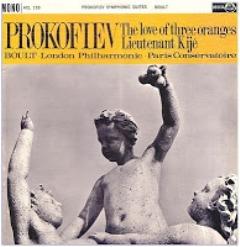Prokofiev: Love of 3 Oranges - Lieutenant Kije (Boult) [1962]
Prokofiev: Love of 3 Oranges - Lieutenant Kije (Boult) [1962]

1. Love of Three Oranges - Symphonic Suite, op.33a London Philharmonic Orchestra Sir Adrian Boult – conductor Recorded: 27-29 June 1955, Kingsway Hall, London 2. Lieutenant Kije - Symphonic Suite, op.60 L'Orchestre de la Societe des Concerts du Conservatoire de Paris Sir Adrian Boult – conductor Recorded: 9 June 1955 - La Maison de la Mutualite, Paris.
Sergei Prokofiev's comic opera The Love for Three Oranges, Op. 33 (1919) won a place in the repertoire only with great difficulty. First produced in 1921, the work was greeted with rather dismal reviews and an even worse public response. Prokofiev found a partial solution to this problem by extracting six numbers from the opera, revising them, and assembling them into a six-movement concert suite in 1924.
"The Ridiculous People," adapted from the opera's prologue, depicts the arguments between the various characters (represented by distinct instrumental ideas) and the ultimate subjugation of their ideas by the forceful Ridiculous People themselves. In "Scene from Hades," Prokofiev uses eerie instrumental effects to represent a card game played by Fata Morgana in Hell. The "March," made famous by dozens of arrangements (it was a staple of violinist Jascha Heifetz's recitals), finds the sick Prince being carried to a party contrived to make him smile. The movement's march rhythms are continually inflected by strident, "wrong-note" sonorities. The remainder of the suite is comprised of "Scherzo" (here reworked into an effective orchestral miniature), a romantic interlude ("The Prince and the Princess"), and "Flight," a comic romp in which the villains are finally routed. --- Blair Johnston, Rovi
Beginning in the 1930s, Prokofiev became one of the first composers of international repute to write music for films. His silver screen career began with the score to Alexander Feinzimmer's Lieutenant Kijé (1933), released in America under the title The Czar Wants to Sleep. Though the film is infrequently encountered today, Prokofiev's music has enjoyed tremendous popularity in its incarnation as a five-movement concert suite. Following Kijé, Prokofiev produced a number of film scores of great distinction, most notably those for Alexander Nevsky (1938) and Ivan the Terrible (1942-1943). So highly regarded were his skills, in fact, that while researching film and sound techniques in Hollywood during 1937-1938, he was offered a then-colossal $2,500 per week to become a full-time film composer. He rejected the offer and returned to the Soviet Union.
The music of Lieutenant Kijé is refreshingly satirical, a perfect counterpart to a story about a nonexistent soldier -- "born" of a copyist's error -- who is provided an identity, a heroic military background, and even a wife. Because the Czar himself is led to believe in Kijé's existence, his courtiers are afraid to tell him the truth. When the Czar desires to meet this great hero, it becomes clear that Kijé must be killed off. The Czar attends Kijé's funeral and, over an empty coffin, laments the loss of such a hero.
The first section of the suite, "The Birth of Kijé," begins with a mournful fanfare on cornets that is followed by comical "military" music on piccolo, flute, and snare drum. After a powerful martial outburst, Kijé's short and rather flaccid theme emerges on tenor saxophone and flute. The "Romance" features a darkly melancholy theme, played on the double bass, of decidedly Russian character. The middle section is more robust; throughout the entire movement, the orchestration remains engaging and colorful. "The Wedding of Kijé" presents the first of the work's two famous themes, a jovial tune on the cornet that serves as a colorful contrast to the pompous music that opens and closes the movement. The lively main theme of the "Troika," set against a glittering backdrop of sleigh bells, is contrasted by sardonic episodes in which brass instruments and pizzicato strings figure prominently. The final "Interment of Kijé" captures the story's ironic humor to splendid effect. Prokofiev begins this section with the same music that opened the suite, after which he presents Kijé's theme. This recap of the work's main material continues with the mournful theme from the "Romance," which carries on unabated when the cornet enters with the jovial wedding tune. These two themes -- one in a slow tempo, the other fast; one melancholy, the other more cheerful -- continue simultaneously, providing one of the most striking moments in the entire work. The "Interment" ends with the mournful cornet music that opened the suite. --- Robert Cummings, Rovi
download: uploaded yandex 4shared mediafire solidfiles mega zalivalka filecloudio anonfiles oboom








